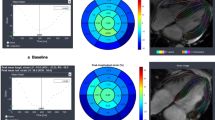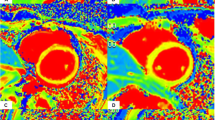Abstract
Objectives
To describe the dynamic changes in cardiac deformation and tissue characteristics using cardiac magnetic resonance (CMR) in asymptomatic patients during 12 months after heart transplantation (HT).
Methods
From April 2020 to January 2021, 21 consecutive HT patients without clinical symptoms were included in this prospective study. Multiparametric CMR was performed at 3, 6, and 12 months after HT. Twenty-five healthy volunteers served as controls.
Results
During follow-up, a decline in left ventricular (LV) global radial strain (GRS) (p = 0.020) and right ventricular (RV) global longitudinal strain (GLS) (p < 0.001) and an increase in post-contrast T1 (p = 0.024) and T2 (p < 0.001) in asymptomatic HT patients occurred at 3 months, which normalized at 6 months postoperatively, compared with those in healthy controls. A decline in LVGLS (p < 0.001) and LV global circumferential strain (GCS) (p < 0.001) and an increase in native T1 (p < 0.001), T2 (p < 0.001), and extracellular volume (ECV) (p < 0.001) occurred at 3 months. Although most parameters improved gradually, LVGLS, native T1, and ECV remained abnormal compared with those in healthy controls at 12 months; only T2 and LVGCS were normalized at 6 months and 12 months, respectively. ECV was significantly correlated with LVGLS, LVGCS, and LVGRS.
Conclusion
Cardiac deformation and tissue characteristics were abnormal early after HT, although the patients were clinically asymptomatic. The dynamic changes in CMR characteristics demonstrate a gradual recovery of myocardial injury associated with transplantation during the first 12 months after HT.
Key Points
• Multiparametric CMR can detect the dynamic changes of transplantation-associated myocardial injury.
• Post-contrast T1, T2, LVGRS, and RVGLS values are normalized at 6 months after HT.
• Native T1, ECV, and LVGLS values remain abnormal compared with those in healthy controls at 12 months after HT.






Similar content being viewed by others
Change history
08 May 2023
A Correction to this paper has been published: https://doi.org/10.1007/s00330-023-09531-1
Abbreviations
- AR:
-
Allograft rejection
- CAV:
-
Cardiac allograft vasculopathy
- CMR:
-
Cardiac magnetic resonance
- ECV:
-
Extracellular volume
- hsTnT:
-
High-sensitivity troponin T
- HT:
-
Heart transplantation
- LGE:
-
Late gadolinium enhancement
- LV:
-
Left ventricular
- LVEF:
-
Left ventricular ejection fraction
- LVGCS:
-
Left ventricular global circumferential strain
- LVGLS:
-
Left ventricular global longitudinal strain
- LVGRS:
-
Left ventricular global radial strain
- LVmassi:
-
Left ventricular mass index
- NT-proBNP:
-
N-terminal pro-brain natriuretic peptide
- RVGLS:
-
Right ventricular global longitudinal strain
References
Stehlik J, Kobashigawa J, Hunt SA, Reichenspurner H, Kirklin JK (2018) Honoring 50 years of clinical heart transplantation in circulation: in-depth state-of-the-art review. Circulation 137:71–87
Potena L, Zuckermann A, Barberini F, Aliabadi-Zuckermann A (2018) Complications of cardiac transplantation. Curr Cardiol Rep 20:73
Kobashigawa J, Zuckermann A, Macdonald P et al (2014) Report from a consensus conference on primary graft dysfunction after cardiac transplantation. J Heart Lung Transplant 33:327–340
Romano S, Judd RM, Kim RJ et al (2020) Feature-tracking global longitudinal strain predicts mortality in patients with preserved ejection fraction: a multicenter study. JACC Cardiovasc Imaging 13:940–947
Kim MY, Park EA, Lee W, Lee SP (2020) Cardiac magnetic resonance feature tracking in aortic stenosis: exploration of strain parameters and prognostic value in asymptomatic patients with preserved ejection fraction. Korean J Radiol 21:268–279
Yu S, Zhou J, Yang K et al (2021) Correlation of myocardial strain and late gadolinium enhancement by cardiac magnetic resonance after a first anterior st-segment elevation myocardial infarction. Front Cardiovasc Med 8:705487
Coelho-Filho OR, Shah R, Lavagnoli CFR et al (2018) Myocardial tissue remodeling after orthotopic heart transplantation: a pilot cardiac magnetic resonance study. Int J Cardiovasc Imaging 34:15–24
Miller CA, Naish JH, Shaw SM et al (2014) Multiparametric cardiovascular magnetic resonance surveillance of acute cardiac allograft rejection and characterisation of transplantation-associated myocardial injury: a pilot study. J Cardiovasc Magn Reson 16:52
Chaikriangkrai K, Abbasi MA, Sarnari R et al (2020) Prognostic value of myocardial extracellular volume fraction and T2-mapping in heart transplant patients. JACC Cardiovasc Imaging 13:1521–1530
Husain N, Watanabe K, Berhane H et al (2021) Multi-parametric cardiovascular magnetic resonance with regadenoson stress perfusion is safe following pediatric heart transplantation and identifies history of rejection and cardiac allograft vasculopathy. J Cardiovasc Magn Reson 23:135
Stewart S, Winters GL, Fishbein MC et al (2005) Revision of the 1990 working formulation for the standardization of nomenclature in the diagnosis of heart rejection. J Heart Lung Transplant 24:1710–1720
Butler CR, Savu A, Bakal JA et al (2015) Correlation of cardiovascular magnetic resonance imaging findings and endomyocardial biopsy results in patients undergoing screening for heart transplant rejection. J Heart Lung Transplant 34:643–650
Knecht KR, Alexander ML, Swearingen CJ, Frazier EA (2012) NTproBNP as a marker of rejection in pediatric heart transplant recipients. Pediatr Transplant 16:335–339
Beliveau P, Cheriet F, Anderson S et al (2015) Quantitative assessment of myocardial fibrosis in an age-related rat model by ex vivo late gadolinium enhancement magnetic resonance imaging with histopathological correlation. Comput Biol Med 65:103–113
Zhou NW, Shu XH, Liu YL et al (2016) A novel method for sensitive determination of subclinical left-ventricular systolic dysfunction in subjects with obstructive sleep apnea. Respir Care 61:366–375
Li X, Kou H, Dong Y et al (2020) The value of 2D speckle-tracking strain echocardiography in evaluating the relationship between carotid elasticity and left ventricular systolic function in patients with diabetic nephropathy. Insights Imaging 11:95
Cochera F, Dinca D, Bordejevic DA et al (2018) Nebivolol effect on doxorubicin-induced cardiotoxicity in breast cancer. Cancer Manag Res 10:2071–2081
Cutruzzola A, Irace C, Frazzetto M et al (2020) Functional and morphological cardiovascular alterations associated with neurofibromatosis 1. Sci Rep 10:12070
Chinali M, Esposito C, Grutter G et al (2017) Cardiac dysfunction in children and young adults with heart transplantation: a comprehensive echocardiography study. J Heart Lung Transplant 36:559–566
Latus H, Hachmann P, Voges I et al (2019) Reduced biventricular volumes and myocardial dysfunction long-term after pediatric heart transplantation assessed by CMR. Transplantation 103:2682–2691
Hu K, Liu D, Herrmann S et al (2013) Clinical implication of mitral annular plane systolic excursion for patients with cardiovascular disease. Eur Heart J Cardiovasc Imaging 14:205–212
Chilian WM (1991) Microvascular pressures and resistances in the left ventricular subepicardium and subendocardium. Circ Res 69:561–570
Cikes M, Solomon SD (2016) Beyond ejection fraction: an integrative approach for assessment of cardiac structure and function in heart failure. Eur Heart J 37:1642–1650
Kraigher-Krainer E, Shah AM, Gupta DK et al (2014) Impaired systolic function by strain imaging in heart failure with preserved ejection fraction. J Am Coll Cardiol 63:447–456
Cikes M, Sutherland GR, Anderson LJ, Bijnens BH (2010) The role of echocardiographic deformation imaging in hypertrophic myopathies. Nat Rev Cardiol 7:384–396
Saleh HK, Villarraga HR, Kane GC et al (2011) Normal left ventricular mechanical function and synchrony values by speckle-tracking echocardiography in the transplanted heart with normal ejection fraction. J Heart Lung Transplant 30:652–658
Ugander M, Bagi PS, Oki AJ et al (2012) Myocardial edema as detected by pre-contrast T1 and T2 CMR delineates area at risk associated with acute myocardial infarction. JACC Cardiovasc Imaging 5:596–603
Anthony C, Imran M, Pouliopoulos J et al (2022) Cardiovascular magnetic resonance for rejection surveillance after cardiac transplantation. Circulation 145:1811–1824
Kfoury AG, Hammond ME, Snow GL et al (2009) Cardiovascular mortality among heart transplant recipients with asymptomatic antibody-mediated or stable mixed cellular and antibody-mediated rejection. J Heart Lung Transplant 28:781–784
Quarles E, Basisty N, Chiao YA et al (2020) Rapamycin persistently improves cardiac function in aged, male and female mice, even following cessation of treatment. Aging Cell 19:e13086
Johnsson C, Gerdin B, Tufveson G (2004) Effects of commonly used immunosuppressants on graft-derived fibroblasts. Clin Exp Immunol 136:405–412
Funding
This work was supported by the National Natural Science Foundation of China (Grant No. 81974262 and 81970288); the Natural Science Foundation of Guangdong Province (Grant No. 2020A1515010650); the Guangdong Cardiovascular Institute Project (Grant No.2020XXG009); and the Guangdong Provincial Key Laboratory of Artificial Intelligence in Medical Image Analysis and Application (Grant No. 2022B1212010011).
Author information
Authors and Affiliations
Corresponding authors
Ethics declarations
Guarantor
The scientific guarantor of this publication is Hui Liu.
Conflict of interest
The authors of this manuscript declare no relationships with any companies whose products or services may be related to the subject matter of the article.
Statistics and biometry
One of the authors has significant statistical expertise. No complex statistical methods were necessary for this paper.
Informed consent
Written informed consent was obtained from all subjects (patients) in this study.
Ethical approval
Institutional review board approval was obtained.
Methodology
• prospective
• observational
• performed at one institution
Additional information
Publisher’s note
Springer Nature remains neutral with regard to jurisdictional claims in published maps and institutional affiliations.
The original online version of this article was revised: only the affiliations 2 & 9 should be assigned to the author Hui Liu.
Supplementary Information
ESM 1
(DOCX 541 kb)
Rights and permissions
Springer Nature or its licensor (e.g. a society or other partner) holds exclusive rights to this article under a publishing agreement with the author(s) or other rightsholder(s); author self-archiving of the accepted manuscript version of this article is solely governed by the terms of such publishing agreement and applicable law.
About this article
Cite this article
Yang, Y., Li, T., Zhou, X. et al. Multiparametric cardiovascular magnetic resonance characteristics and dynamic changes in asymptomatic heart-transplanted patients. Eur Radiol 33, 4600–4610 (2023). https://doi.org/10.1007/s00330-022-09358-2
Received:
Revised:
Accepted:
Published:
Issue Date:
DOI: https://doi.org/10.1007/s00330-022-09358-2




